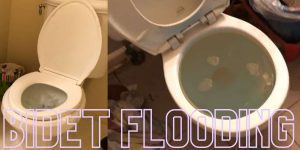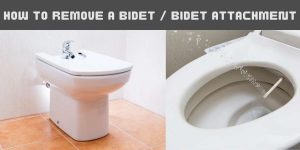Bidet Truth: Unveiling-Do Bidets Spray Poop Everywhere?
Many people have doubts and fears about using bidets. They wonder: do bidets spray poop everywhere?
The answer is a resounding No, when used correctly, bidets do not create a mess, although some splattering may occur. Excessive pressure can lead to minor issues, but modern bidets typically feature a gentle stream to minimize this risk.
Electric bidets use a flow rate of about 0.1 gallons per minute, ensuring a controlled and clean experience. Non-electric bidets offer soft streams, though they rely on home water pressure, potentially reaching higher levels.
Throughout this article, we’ll delve into why bidets are generally less messy than traditional toilet seats.
Additionally, we’ll share practical tips on preventing splashing, helping you maintain and even enhance your bathroom hygiene, especially if you’ve made the switch to a high-tech toilet. Let’s ensure a clean and worry-free bidet experience!
The Problem: How to Avoid Getting Poop on Your Bidet
Some people may encounter a problem when using a bidet: getting poop on the bidet itself. This can be unpleasant and unsanitary, and it can also damage the bidet over time.
Fortunately, there are some simple ways to prevent this from happening,
such as:
Checking the Water Pressure.
One of the main causes of poop getting on the bidet is low water pressure. If the water pressure is too weak, it may not be able to remove all the waste from your skin, leaving some traces on the bidet’s surface.
To avoid this, you should always check the water pressure before using the bidet, and adjust it to a comfortable and effective level. You can do this by turning the knob or lever that controls the water flow, or by using a remote control if the bidet has one.
You can also test the water pressure by spraying it on your hand first, and then moving it to your desired area.
Positioning Yourself Correctly:
Another reason why poop may get on the bidet is improper positioning. If the bidet nozzle is not pointing at the right angle, it may not reach the areas that need to be cleaned, or it may spray water beyond them, resulting in poop getting on the bidet or the floor.
To avoid this, you should always position yourself correctly on the bidet, depending on the type of bidet you are using.
For a freestanding bidet, you should straddle it and face the water controls, so you can see and adjust the water direction and pressure.
For a built-in bidet, you should sit on the toilet seat and align your anus with the nozzle, which usually comes out from the back or the side of the rim.
For a handheld bidet, you should hold the nozzle near your anus and aim it carefully, while controlling the water pressure with a button or a trigger.
Following the Instructions:
A final factor that can contribute to poop getting on the bidet is user error.
If you do not use the bidet properly, or if you do not follow the manufacturer’s instructions, you may end up with a messy and unsatisfying experience.
To avoid this, you should always read the instructions that come with the bidet, or look for online guides or videos on how to use it.
Some general tips to remember are:
– Use the toilet first, and wipe away any excess poop with toilet paper before using the bidet.
– Do not use soap or detergent on the bidet, as this can damage the nozzle or the plumbing system.
– Do not move around too much while using the bidet, as this can cause the water to splash or miss the target.
– Dry yourself with a clean towel or a tissue after using the bidet, and do not use the same towel that is meant for drying your hands.
– Wash and dry your hands after using the bidet, and turn off the water valve if the bidet has one.
You can enjoy using a bidet without getting poop on it. Just follow these easy steps. A bidet makes you feel fresh and clean, and it also helps you save money and the environment by using less toilet paper. I hope you learned something new from me.
Why Don’t Bidets Splash Poop Everywhere? The Design Factors
Bidets are designed to be efficient and discreet when it comes to cleaning. Manufacturers conduct extensive research, quality assurance, and user testing to ensure that bidets meet the necessary standards. Here are some design factors that prevent bidets from splattering waste everywhere
1. Controlled Pressure:
Bidets allow users to control the water pressure, reducing the chances of excessive force causing splashing. You can adjust the pressure using a knob, lever, or control buttons, ensuring a comfortable and effective cleaning experience.
2. Highly Targeted Flow:
Bidets have a precise and focused water flow, minimizing the chances of missing the intended area. The bidet shower controls the spraying process, ensuring that the water reaches the desired target without any unnecessary splashing.
3. Sleek Design:
Bidets are designed with a streamlined shape that minimizes the spraying effect. The shape and dimensions of the bidet are carefully considered to make it easy to operate and ensure that the water flows straight, reducing the risk of missing the target area.
4. Protected and Self-Cleaning Wands:
Bidet wands are designed to prevent any contact with toilet water or waste. They are slanted to avoid collecting excrement and are usually covered behind a guard when not in use. Additionally, many bidet wands are self-cleaning, ensuring cleanliness before and after each use.
How to Prevent Bidet Splashes? Tips for a Clean Experience
While bidets are designed to minimize splashing, there are a few tips you can follow to ensure a clean experience:
1. Avoid Full Pressure Mode:
You don’t need to use excessive water pressure when using a bidet. Start with the lowest setting and adjust it to your preference. Only certain low-pressure bidets may require additional power for proper functionality.
2. Target Precisely:
Aim the spray accurately by keeping the nozzle pointed down and in the middle. This will help prevent any unnecessary splashing.
3. Sit Properly:
Ensure that you are sitting properly on the bidet to maximize its effectiveness. Your legs should be stretched and wide enough to allow your rear to approach the bidet. This will prevent any air gaps and reduce the chances of waste splashes.
4. Start Slowly:
If you are new to using a bidet, take your time to familiarize yourself with its features. Start with a low-pressure setting and gradually increase it as you become more comfortable. This will help you develop muscle memory and improve your cleaning experience.
How to use a bidet properly:
To use a bidet properly, you should follow these steps:
- Stay on the toilet seat after you finish your business and make yourself comfortable on the bidet seat.
- Turn on the bidet using the buttons or knobs that control it. You can change the water pressure and temperature to suit your liking.
- Aim the water jet towards the area that you want to clean, making sure that it covers everything.
- When you feel clean enough, dry the area with a clean towel or some toilet paper.
How to keep your bidet clean:
Using a bidet can help you keep your private parts clean, but you also need to keep your bidet clean. Here are some tips to do that:
- Use mild, pH-balanced soaps or washes with the bidet for extra hygiene and freshness. Avoid using harsh chemicals or detergents that can damage the bidet or the plumbing system.
- Clean the bidet nozzle or jet regularly to avoid the accumulation of bacteria or dirt. You can use a soft cloth or a brush to wipe it gently.
- Dry the area well after using the bidet to prevent any moisture-related problems. You can also use a fan or a dryer if the bidet has one.
The bottom Line
While concerns about bidets getting poop on them are valid, understanding the reasons behind this problem and implementing the provided solutions can help mitigate the issue.
By ensuring optimal water pressure, proper positioning, following manufacturer’s instructions, and practicing regular cleaning and maintenance, you can enjoy a clean and hygienic bidet experience, leaving no room for poop-related worries.
FAQs
1. Do bidets get poop on them?
While bidets are designed to clean and sanitize after using the toilet, it is possible for some fecal matter to come into contact with the bidet. However, modern bidets are equipped with various features and technologies to minimize any potential mess or cross-contamination.
2. How does a bidet prevent poop from getting on it?
Bidets typically feature a targeted water spray that is directed towards the user’s posterior, effectively cleaning without the need for toilet paper. Additionally, many bidets have adjustable water pressure and nozzle positions to ensure thorough cleansing while minimizing the chances of poop coming into contact with the bidet.
3. What measures are taken to keep bidets clean?
Manufacturers employ different mechanisms to maintain bidet cleanliness. Some bidets have self-cleaning nozzles that rinse before and after each use, while others use antimicrobial materials or coatings to inhibit the growth of bacteria. It is also recommended to regularly clean and disinfect your bidet according to the manufacturer’s instructions.
4. Can bidets spread bacteria or germs?
When used properly, bidets are considered hygienic and can actually help reduce the spread of bacteria and germs compared to using toilet paper alone. The water used in bidets is typically clean and can effectively remove residue, potentially reducing the risk of contamination. However, it is essential to maintain good personal hygiene practices and regularly clean your bidet to minimize any potential risks.
5. Are bidets suitable for everyone, including people with mobility issues?
Bidets can be a great option for individuals with mobility issues or certain health conditions. Many bidets offer additional features such as heated seats, adjustable water temperature, and remote control operation, making them more accessible and user-friendly. However, it is important to consider individual needs and consult with healthcare professionals if necessary to determine the most suitable bidet model.





